SUP Buying Guide (2021)
There is no perfect board. There are trade offs to every board you choose. This piece of content aims to put your mind at ease by helping you make a more informed decision.
· What Is Stand Up Paddleboarding (SUP)?
· What Are The Different Types And Uses Of SUP Boards?
· Do I Get A Solid Or An Inflatable Stand Up Paddle Board?
· What Size Of A Paddle Board Do I Need?
· What Kind Of A Paddle Do I Need?
· I’ve Got The Board And The Paddle, What Other Stuff Do I Need?
· How Do I Look After My iSUP Or SUP?
What Is Stand Up Paddleboarding (SUP)?
Essentially, SUP is a kind of watersport where you stand on a specialized surfboard while using a paddle to maneuver on the water. It’s an exciting way to explore the nature from a new angle all the while excercising (low-impact full-body workout).
Suitable for people of all ages. Some forms of SUP simply take more practise, assuming you got the right equipment.
What Are The Different Types And Uses Of SUP Boards?
In this section of SUP buying guide, you’ll learn about 10 types of stand up paddle boards and their uses:
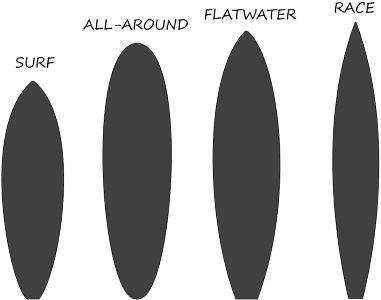
1. all-around;
2. fishing;
3. flatwater / touring;
4. flatwater / open ocean;
5. racing;
6. surfing;
7. whitewater / river riding;
8. wide SUP;
9. windSUP;
10. yoga.
1. All-Around
ALL-AROUND SUP boards are the most verstile of them all, good for flatwater, open ocean and even river riding. With the most common stand up paddle board shape, these multi-purpose boards are a good choice for when you first start out with the sport as you get to try it out on almost all fronts (this article has more info on What is All-Around SUP).
Average length: 10′ – 12’6”
Average width: 30” – 34”
2. Fishing
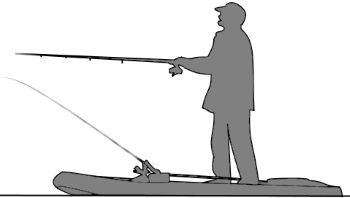
FISHING stand up paddle boards are purpose-built SUP platforms (they come in many forms) for, you guessed it, fishing, combining the challenging sport of stand up paddle boarding with the thrilling sport of fishing and thus making it all the more rewarding of an activity.
The nose of the board should be pointy rather than rounded, or if rounded, not with too big of a lift – waves, even the little ones, will otherwise hit the bottom of the nose and make a loud enough sound and scare the fish away. Also, bare minimum setup – the more simple it is, the less stress there is and thus the more enjoyable it is overall .
3. Flatwater / Touring
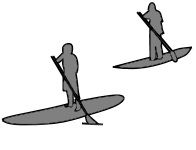
FLATWATER / TOURING SUP boards are typically longer, narrower and usually with a rounded pointy nose when compared to all-around SUP boards so as to cruise through longer distances smoothly and faster while having less trouble keeping a straight line. Good for longer distance travels/tours (this article has more info on SUP Touring).
Average length: 11′ – 14′
Average width: 28” – 32”
4. Open Ocean
OPEN OCEAN SUP boards are similar to flatwater/touring boards. They’re longer, narrower and with a rounded point nose when compared to all-around SUP boards so as to slice through waves. The only difference might be in having a greater rocker(lift) in the nose to better cope with the waves, such a nose will slow you down more in flatwater conditions however. Otherwise, good for longer distance travels/tours.
Average length: 11′ – 14′
Average width: 28” – 32”
5. Racing
RACING SUP boards are typically longer, narrower and with a pointy nose when compared to all-around SUP boards so as to slice through the water more efficiently, making the ride faster and smoother.
There are two SUP racing categories: 12’6” and under for sprint races, and 14′ for long distance races.
The average width of a race paddleboard: 25” – 29”
6. Surfing

SURFING SUP boards are shorter than all-around SUP boards, they’re also narrower, especially from the back and front, typically with pointed or rounded point nose. The narrower, the better, but it will take more effort to balance yourself on a narrower board.
Average length: 7′ – 10’5”
Average width: 27” – 32”
7. Whitewater / River Riding
WHITEWATER / RIVER RIDING SUP boards are smaller and with a rocker(lift) on the nose when compared to all-around SUP boards, otherwise they’re similar. It’s generally recommended to use an inflatable SUP (iSUP) as it’s much more durable in the more extreme environments, in rapids for example, than a solid SUP board is. Yes, you heard it right – inflatable SUPs are more durable against such elemements.
Average length: 10′ and under
Average width: 30” – 35”
8. Wide SUP
WIDE SUPs are just wide.
9. WindSUP
WINDSUPs are purpose-built boards that cover windsurfing and paddle boarding in one.
Average lenght: 9′ – 12′
Average width: 30” – 34”
10. Yoga
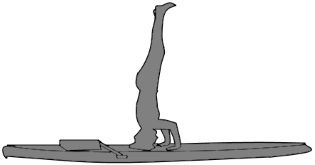
Although generally almost anything to do with riding a SUP is an excercise, yoga, or FITNESS, on a SUP board is even more thought-provoking. An inflatable SUP board (iSUP) is usually recommended over a solid SUP board for excercising purposes as it’s simply more comfortable.
Apart from that, almost any board is good to go for this, but wider is better than narrower.
This is not a complete list of the types and uses of SUP in 2021 but of the most popular ones.
What Type Of SUP Is For Me?
What type of stand up paddle boarding are you going to want to and be able to do the most?
Surfing? River riding? Fishing? Yoga? Windsurfing? Touring? Racing? All of them (All-around)?
Where will you be able to use your SUP The most?
Ocean? Lake? River?
What are your expectations?
The rush? Relaxation? The journey? Speed?
General overview of shapes:
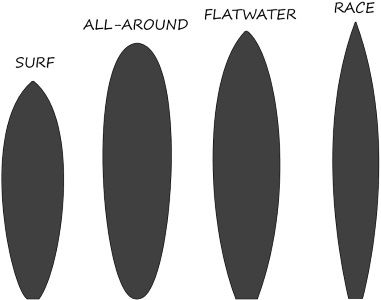
Important!
The type of board determines how it performs and handles in relation to your expectations.
Nobody says you can’t, for example, surf with a touring board – it will simply be more difficult.
In case you wish to do a bit of everything, the all-around board is your best pick.
Have an idea what type of SUP is for you? Scroll up to the section before this one and learn more about it.
General rule of thumb:
· The wider the board, the more stable it is (all-around, fishing, fitness),
· The narrower the board, the faster it is (racing, surfing).
· The longer the board, the more speed it can build up (racing, touring).
· The shorter the board, the better maneuverability you get (whitewater, surfing)
Do I Get A Solid Or An Inflatable Stand Up Paddle Board?
Whichever you choose depends on what your needs are. Most enthusiasts have them both.
Inflatable stand up paddle boards (iSUPs) are made of sturdy material that can be inflated (approx 10 min) and deflated, making them easy to travel with as the deflated board and the pump can be stored in a backpack. Although surprisingly tough at the right air pressure, it’s generally better suited for non-competitive watersporting (but not excluding competitive watersporting), such as river riding, fitness, all-around, family time, vacation, exploration, time-off, relaxation etc (doesn’t crack, dent nor scratch).
Knowing the general price range for inflatable SUP boards is good to have in mind.
Solid stand up paddle boards are made of solid material, making them better for performance based stand up paddle boarding activities like racing and surfing at high levels of competition. More difficult to store and travel with.
What Size Of A Paddle Board Do I Need?
In relation to your weight, SUP boards have different lenghts and volumes to them accordingly. Following are simplified charts to give you a better idea of what size and volume paddleboard you need.
What lenght of a SUP board do I need? (see charts)
Surf SUP board size chart
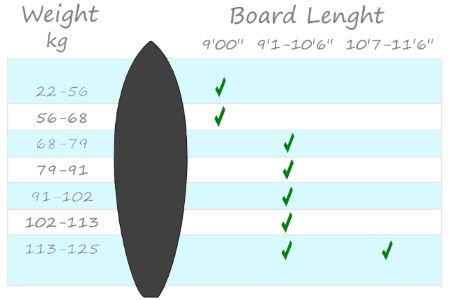
All-around SUP board size chart
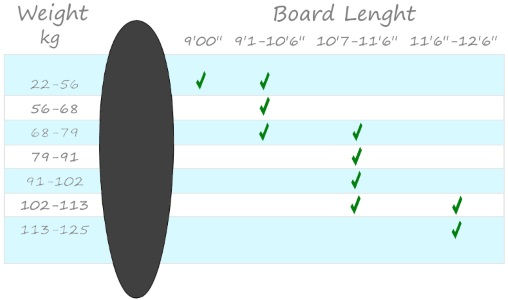
Flatwater/race SUP board size chart
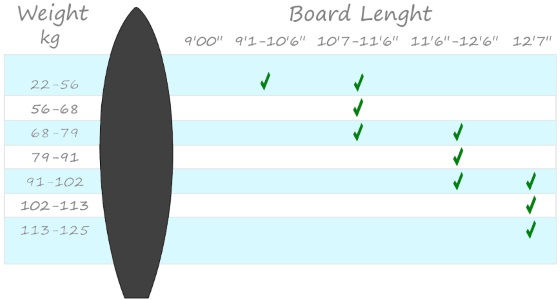
What volume of a SUP board do I need? (see chart)
1 liter (L) = 1 kilogram (kg)
2.2 pounds (lb) = 1 kilogram (kg)
Note that when you’re on a SUP board with volume 2x your weight (in kilograms), half of the board should be under water when you’re standing on it and not riding. The less it’s under water, the faster it is at the cost of maneuverablity, but best not to go to extremes with either case. Need to account for the extra weight from accessories, wetsuit, etc, too.
What Kind Of A Paddle Do I Need?
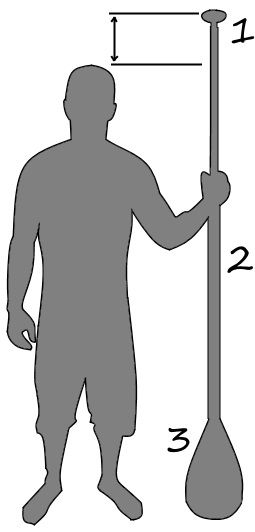
One of the more important things to keep in mind is the height of the paddle in relation to your height depending what type of SUP you’re going for.
Some paddles are adjustable, but generally:
· Surf SUP paddles are usually between 6-8 inches above the paddlers height due to lower stance taken in surfing.
· Flatwater SUP paddles are usually between 8-10 inches above the paddlers height for improved reach and power in each paddle stroke.
· Racing SUP paddles are usually between 10-12 inches above the paddlers height for maximum reach and power in each paddle stroke for speed.
The paddle consists of 3 parts:
· 1. handle – ergonomic shape, “T” shape, etc,
· 2. shaft – made of different materials:
§ Carbon – most common material, provides the paddle with stiffness and memory,
§ Glass fibre – budget material, can bend more, makes the paddle softer in the stroke,
§ Aluminium – rigid material, can be heavy,
§ Kevlar – high impact resistance, performs similarly to Carbon;
· 3. blade – sizes vary from large to small:
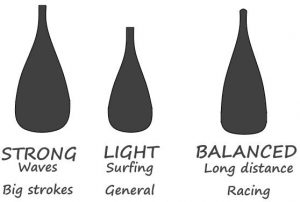
I’ve Got The Board And The Paddle, What Other Stuff Do I Need?

The basics (in more rough conditions):
· leash (so as to not get separated from the board),
· life jacket (PFD) (in case something unexpected were to happen),
· wetsuit (for when it might be too cold otherwise, etc),
Additional safety gear:
· protective gear (helmet, shin and knee pads),
· whistle (to signal further with less effort),
· flashlight (when the sun sets and it’s too dark otherwise),
· phone / GPS locator beacon (might prove useful if the unexpected happens),
· ID sticker (were you to be separated from your board, it can be returned to you, unless you were nowhere to be found, in which case likely a rescue operation is launched instead).
Other accessories:
· protective bag (for covering the board from potentially damaging elements),
· repair kit (for patching up “problems”).
How Do I Look After My iSUP Or SUP?
Inflatable SUP Maintenance
· iSUP Care And Maintenance – A More In-Depth Look
· Store your iSUP board out of the sun in a dry and shaded area.
· Be careful where you put the board in the water, there may be rocks or other sharp objects underneath that may damage the board.
· Be careful when you are paddling and avoid any obstructions that can damage your board, paddle, or fin.
· Wash your SUP equipment after going in saltwater.
· Don’t drag your iSUP board – when you’re taking your board in or out of the water, don’t let it drag over rocks, debris or even sand.
· Don’t stack stuff on top of your board, iSUPs may get pressure dings otherwise. Dings cause an uneven surface and therefor a slower, bumpier ride.
· Regularly check for holes and the like in your iSUP board – the sooner you catch them, the sooner you can deal with them.
· Clean your equipment every now and then. Simply hosing over the board after salt water paddling can prevent a salty crust from forming or various bacteria from growing.
Solid SUP Maintenance
· Store your SUP equipment out of the sun in a dry and shaded area.
· Transport your SUP paddle and board in a protective bag to prevent damage.
· Be careful where you put the board in the water, there may be rocks or other sharp objects underneath that may damage the board.
· Be careful when you are paddling and avoid any obstructions that can damage your board, paddle, or fin.
· If you have a vent plug, close it when you go out on the water. This will stop water getting into your solid SUP board and damaging the foam core.
· Wash your SUP equipment after going in saltwater.
· Regularly check for dings and cracks on your board and paddle. Especially your board’s nose and rails. Those are the two most common areas that get damaged.
· If you find anything that has the potential to let water into your SUP board, get it taken care of immediately. You can use a ding tape to patch it if it’s not serious damage or if you are not able to repair it right away.
